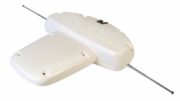Yeah, the first time you see it, it can be a little disquieting. But really, a large antenna is going to flex and sway in the wind. Antennas are generally built out of aluminum which, while strong, has more flex than steel. Not only that, most antennas today are designed to be as light as possible meaning that as little metal is used as possible. This is a cost-cutting move, yes, but let’s be honest; you probably wouldn’t buy a $500 antenna or even a $50 antenna that costs $500 to ship. Such an antenna would be really amazing and probably last forever, but it still wouldn’t get better reception.
It also doesn’t help that some antennas like the one seen above basically look like kites. The whole purpose of an antenna, after all, is to catch signals. Depending on the design, this can mean that they put a lot of their surface area pointing toward the towers. This can create issues with wind.
The science of wind loading
The tendency of an antenna to move in the wind is expressed as its wind load. For the most part you don’t really need to understand wind load other than knowing that manufacturers design antennas so that the wind load isn’t excessive. There’s very little chance of an antenna flying off in anything less than a hurricane. That’s by design. Wind load is important, yes, but it’s so unimportant to most consumers that it’s practially impossible to get wind load information from antenna makers.
Don’t sweat it
So yes, a certain amount of flex is normal. Don’t try to fight it by overtightening bolts, because that’s just going to deform the antenna. If you’re concerned about it drifting off-aim you can try some steps to brace it such as using scrap aluminum or metal you may have left over from other projects. You can also drill through the mount to thread a bolt in between the antenna and the mast. This won’t stop the shaking and flexing but it should stop the antenna from drifting off aim. You can also do the same thing at the point where the mast mounts to the roof or chimney if you’re concerned.
Before you do anything, however, it’s important to understand the difference between an antenna that shakes in the wind now and again and one that’s actually making a difference in reception. A little bit of shimmy isn’t going to affect reception except in really fringe areas. It may be disquieting, but that doesn’t mean it’s a problem.
In fact, a little bit of flex is going to keep your antenna from tearing itself apart, just as we’re taught as kids that the mighty oak has as its greatest strength the ability to bend with the wind. Of course, let’s be honest here; no antenna is going to stand up to hurricane force winds and you shouldn’t expect that. What you should expect is that minor shimmies and shakes are going to happen, and there’s no reason to get all worked up about it.
Get the right antenna
When you’re ready to upgrade to 100% free live television using an antenna, you’ll want the best selection and advice. You can get both by shopping for what you want at Solid Signal.





